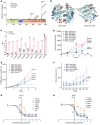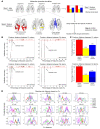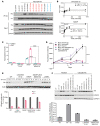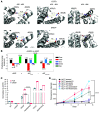Somatic estrogen receptor α mutations that induce dimerization promote receptor activity and breast cancer proliferation
- PMID: 37883178
- PMCID: PMC10760953
- DOI: 10.1172/JCI163242
Somatic estrogen receptor α mutations that induce dimerization promote receptor activity and breast cancer proliferation
Abstract
Physiologic activation of estrogen receptor α (ERα) is mediated by estradiol (E2) binding in the ligand-binding pocket of the receptor, repositioning helix 12 (H12) to facilitate binding of coactivator proteins in the unoccupied coactivator binding groove. In breast cancer, activation of ERα is often observed through point mutations that lead to the same H12 repositioning in the absence of E2. Through expanded genetic sequencing of breast cancer patients, we identified a collection of mutations located far from H12 but nonetheless capable of promoting E2-independent transcription and breast cancer cell growth. Using machine learning and computational structure analyses, this set of mutants was inferred to act distinctly from the H12-repositioning mutants and instead was associated with conformational changes across the ERα dimer interface. Through both in vitro and in-cell assays of full-length ERα protein and isolated ligand-binding domain, we found that these mutants promoted ERα dimerization, stability, and nuclear localization. Point mutations that selectively disrupted dimerization abrogated E2-independent transcriptional activity of these dimer-promoting mutants. The results reveal a distinct mechanism for activation of ERα function through enforced receptor dimerization and suggest dimer disruption as a potential therapeutic strategy to treat ER-dependent cancers.
Keywords: Breast cancer; Drug therapy; Endocrinology; Oncology; Sex hormones.
Figures




Similar articles
-
Estrogen receptor α L543A,L544A mutation changes antagonists to agonists, correlating with the ligand binding domain dimerization associated with DNA binding activity.J Biol Chem. 2013 Jul 19;288(29):21105-21116. doi: 10.1074/jbc.M113.463455. Epub 2013 Jun 3. J Biol Chem. 2013. PMID: 23733188 Free PMC article.
-
The F-domain of estrogen receptor-alpha inhibits ligand induced receptor dimerization.Mol Cell Endocrinol. 2008 Nov 25;295(1-2):94-100. doi: 10.1016/j.mce.2008.08.001. Epub 2008 Aug 13. Mol Cell Endocrinol. 2008. PMID: 18762230
-
Surveying helix 12 dynamics within constitutively active estrogen receptors using bipartite tetracysteine display.J Biol Chem. 2025 Mar;301(3):108231. doi: 10.1016/j.jbc.2025.108231. Epub 2025 Jan 27. J Biol Chem. 2025. PMID: 39864623 Free PMC article.
-
Breast cancer-derived M543V mutation in helix 12 of estrogen receptor alpha inverts response to estrogen and SERMs.Breast Cancer Res Treat. 2010 Apr;120(3):761-8. doi: 10.1007/s10549-009-0437-7. Epub 2009 Jun 13. Breast Cancer Res Treat. 2010. PMID: 19526339
-
2',3',4'-Trihydroxychalcone changes estrogen receptor α regulation of genes and breast cancer cell proliferation by a reprogramming mechanism.Mol Med. 2022 Apr 25;28(1):44. doi: 10.1186/s10020-022-00470-z. Mol Med. 2022. PMID: 35468719 Free PMC article.
Cited by
-
eIF4A controls translation of estrogen receptor alpha and is a therapeutic target in advanced breast cancer.Proc Natl Acad Sci U S A. 2025 Jul 29;122(30):e2424286122. doi: 10.1073/pnas.2424286122. Epub 2025 Jul 21. Proc Natl Acad Sci U S A. 2025. PMID: 40690678 Free PMC article.
-
Asymmetric allostery in estrogen receptor-α homodimers drives responses to the ensemble of estrogens in the hormonal milieu.Proc Natl Acad Sci U S A. 2024 Jun 11;121(24):e2321344121. doi: 10.1073/pnas.2321344121. Epub 2024 Jun 3. Proc Natl Acad Sci U S A. 2024. PMID: 38830107 Free PMC article.
-
Estrogen Receptor Alpha Mutations, Truncations, Heterodimers, and Therapies.Endocrinology. 2024 Apr 29;165(6):bqae051. doi: 10.1210/endocr/bqae051. Endocrinology. 2024. PMID: 38643482 Free PMC article. Review.
-
Novel antibody language model accelerates IgG screening and design for broad-spectrum antiviral therapy.bioRxiv [Preprint]. 2024 Aug 20:2024.03.01.582176. doi: 10.1101/2024.03.01.582176. bioRxiv. 2024. PMID: 38496411 Free PMC article. Preprint.
-
Correlation between the RNA Expression and the DNA Methylation of Estrogen Receptor Genes in Normal and Malignant Human Tissues.Curr Issues Mol Biol. 2024 Apr 19;46(4):3610-3625. doi: 10.3390/cimb46040226. Curr Issues Mol Biol. 2024. PMID: 38666956 Free PMC article.
References
Publication types
MeSH terms
Substances
Grants and funding
LinkOut - more resources
Full Text Sources
Medical
Miscellaneous

